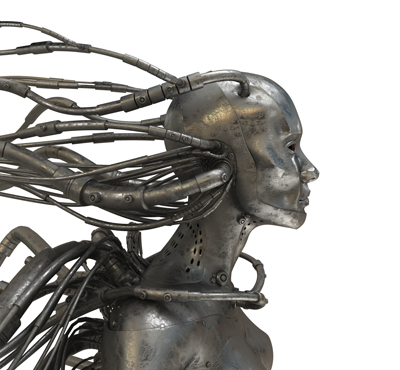
|
I tend to keep my fingernails short—not into the quick but close to it. So every month or six weeks, after trimming them, I experience a week or so when I exist like one of those robots with grip-sensitive finger pads like we see on television and in advanced science articles but not much with which to cut or scrape. Articles written about robots deal with joint articulation, wrist movement, and grip pressure. But no one seems to imagine what a humanoid robot without fingernails would go through on a daily basis.1
Take that little spot of dried goo on a mirror, plastic countertop, or other and more scratchable surface. Abrasion with a fingertip or a rubberized grip pad won’t quite wear it away. The keratin in a fingernail—akin to the protein that makes up strands of your hair—has just the right combination of hardness, flexibility, but ultimate softness and “give” to wipe away that spot without marring the underlying finish.
Take Ziplock bags. When they really stick, so that just pulling on the outside or inside bag material merely tears along the zipper seam, only a fingernail gently inserted between the two lips can tease them apart without compromising the bag’s sealing properties.
Take the snap tabs on soft drink cans and the peelable edges of the stickers on fruit, the price stickers on items intended as gifts, and virtually anything else that adheres or clamps but is intended to come loose with a soft edge and a little pressure. Trying to get a purchase under that edge with a fingertip, using friction from the ridges of your fingerprint, will almost but not quite work. To really get a grip, you need a fingernail.
And, as I read somewhere, while fingernails originated in animal claws, fighting weapons for everything from house cats to bears, their main evolutionary purpose in humans has been to anchor the skin around the fingertip, enhancing our grip on everything we grasp.
Consider every time you use a fingernail in your daily life, every time it has saved you going into the utility drawer for a screwdriver or a spatula, and you can see where lack of nails would hamper the effectiveness of a humanoid household robot. To overcome this disadvantage, designers would have to give the machine an extensible blade of soft-but-not-too-soft plastic—and replace it every time it wore away in use.
About the only thing a human does that a robot doesn’t is scratch him- or herself, and for that fingernails are perfect, too.
But maybe we shouldn’t speak too widely about the usefulness of fingernails. When the apocalypse comes, we can send messages on the underside of peelable stickers and store life’s essentials in Ziplock bags—and then use them to defeat our robot overlords.
1. Of course, most robots in the real world to come will not have humanlike hands, with fingers, opposable thumbs, and gripping pads. They will not be the bipedal, mannequin-bodied, humanoid surrogates imagined in early science fiction like I, Robot. The mechanisms that we wish to automate will have intelligence embedded in their systems. And the artificially intelligent software that guides and makes decisions for them will be so easily reproducible and installable that no one would bother to pay for a multi-function humanoid robot.
Would you design a robot with just two cameras for binary vision, two audio receptors for directional hearing, two hands to grip a steering wheel, and two feet to operate accelerator and brake pedals in order to drive a car? And what then—your robot chauffeur would get out, go into the kitchen, pick up a paring knife, and slice carrots? Of course not. You would automate a self-driving car with multiple cameras and other sensors, including radar, and hook its decision-making capacity directly into the engine and brake management systems. And you would have a separate kitchen ’bot to prepare and serve food. A thousand other chores would be handled at the point of function by specifically designed automated systems. That is the future we’re headed toward.
No comments:
Post a Comment